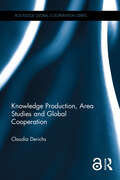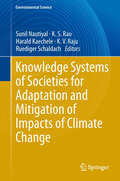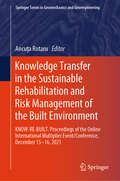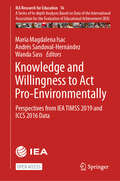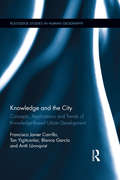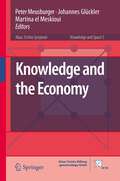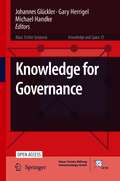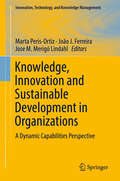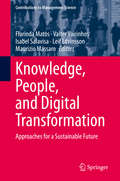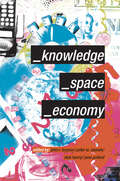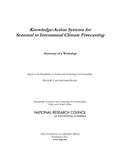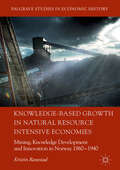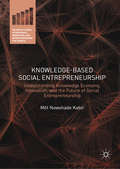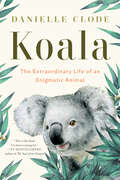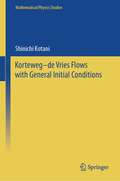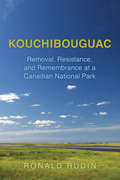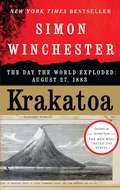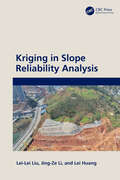- Table View
- List View
Knowledge Production, Area Studies and Global Cooperation (ISSN)
by Claudia DerichsWhereas Area Studies and cross-border cooperation research conventionally demarcates groups of people by geographical boundaries, individuals might in fact feel more connected by shared values and principles than by conventional spatial dimensions. Knowledge Production, Area Studies and Global Cooperation asks what norms and principles lead to the creation of knowledge about cross-border cooperation and connection. It studies why theories, methods, and concepts originate in one place rather than another, how they travel, and what position the scholar adopts while doing research, particularly ‘in the field’.Taking case studies from Asia, the Middle East and North Africa, the book links the production of alternative epistemologies to the notion of global cooperation and reassesses the ways in which the concept of connectedness can be applied at the translocal and individual rather than the formal international and collective level.Knowledge Production, Area Studies and Global Cooperation provides an innovative and critical approach towards established means of producing knowledge about different areas of the world, demonstrating that an understanding of pluri-local connectivity should be integrated into the production of knowledge about different areas of the world and the behavioural dimension of global cooperation. By shifting the view from the collective to the individual and from the formal to often invisible patterns of connectedness, this book provides an important fresh perspective which will be of interest to scholars and students of Area Studies, Politics, International Relations and Development Studies. The Open Access version of this book, available at http://www.taylorfrancis.com, has been made available under a Creative Commons Attribution-Non Commercial-No Derivatives (CC-BY-ND) 4.0 license.
Knowledge Systems and Change in Climate Governance: Comparing India and South Africa (Routledge Advances in Climate Change Research)
by Babette NeverThe success of international efforts to manage climate change depends on the participation of emerging economies. This book uses a comparative study of two of the most important, India and South Africa, to reveal new insights into managing climate change on a global scale. The book provides a unique in-depth analysis of how these two countries are dealing with climate change at both national and province levels, from India’s advances in solar and wind energy development to South Africa’s efforts to introduce a carbon tax. Using the innovative theoretical framework of climate knowledge systems, it explores how people in India and South Africa engage with one other, learn and act by forming communities of practice. The book identifies the drivers and barriers of climate governance, showing how different forms of scientific, technological, normative and pragmatic knowledge can aid climate governance and analysing how the underlying mind-set that guides climate action in these countries is changing. This book is a valuable resource for students and scholars of environmental policy, politics and governance, as well as comparative politics, climate change and sustainable development.
Knowledge Systems of Societies for Adaptation and Mitigation of Impacts of Climate Change
by K. V. Raju Sunil Nautiyal Ruediger Schaldach Harald Kaechele K. S. RaoClimate change is broadly recognized as a key environmental issue affecting social and ecological systems worldwide. At the Cancun summit of the United Nations Framework Convention on Climate Change's 16th Conference, the parties jointly agreed that the vulnerable groups particularly in developing countries and whose livelihood is based on land use practices are the most common victims as in most cases their activities are shaped by the climate. Therefore, solving the climate dilemma through mitigation processes and scientific research is an ethical concern. Thus combining the knowledge systems of the societies and scientific evidences can greatly assist in the creation of coping mechanisms for sustainable development in a situation of changing climate. International Humboldt Kolleg focusing on "knowledge systems of societies and Climate Change" was organized at ISEC. This event was of unique importance, as the year 2011-12 was celebrated as the 60th Anniversary of Diplomatic Relations between India and Germany with the motto "Germany and India - Infinite Opportunities." This volume is the outcome of the papers presented during the IHK 2011 at ISEC, India.
Knowledge Transfer in the Sustainable Rehabilitation and Risk Management of the Built Environment: KNOW-RE-BUILT. Proceedings of the Online International Multiplier Event/Conference, December 15-16, 2021 (Springer Series in Geomechanics and Geoengineering)
by Ancuța RotaruThis book showcases the valuable contributions made during the online event entitled The International Conference on Knowledge Transfer in the Sustainable Rehabilitation and Risk Management of the Built Environment. The conference was held on December 15–16, 2021, and was organized as a multiplier event of the European project Rehabilitation of the Built Environment in the Context of Smart City and Sustainable Development Concepts for Knowledge Transfer and Lifelong Learning (RE-BUILT). This book specifically retains the same main themes explored in the book titled Critical Thinking in the Sustainable Rehabilitation and Risk Management of the Built Environment – CRIT-RE-BUILT. The papers included in this book are mostly authored by partners in the project’s consortium and cover various aspects of civil engineering knowledge transfer in crucial areas, to address different perspectives and significant challenges related to the sustainable built environment. The book seeks to provoke ideas and discussions, particularly in the areas where risk management and sustainable rehabilitation of the built environment intersect, ranging from reducing hazard risks to enhancing sustainable rehabilitation efforts in the field
Knowledge and Willingness to Act Pro-Environmentally: Perspectives from IEA TIMSS 2019 and ICCS 2016 Data (IEA Research for Education #16)
by Andrés Sandoval-Hernández Maria Magdalena Isac Wanda SassThis open access book utilizes data from two large-scale international assessments—TIMSS 2019 and ICCS 2016—to investigate the extent to which education for sustainable development outcomes is conveyed and accomplished within various educational systems. Specifically, it aims to expand the understanding of how students' environmental knowledge levels and their willingness to act in a pro-environmentally manner can differ across and within countries. The book also examines whether certain opportunities to learn about environmental issues in secondary schools show promise in enhancing young people's environmental knowledge and attitudes.
Knowledge and the City: Concepts, Applications and Trends of Knowledge-Based Urban Development (Routledge Studies in Human Geography #52)
by Tan Yigitcanlar Francisco Javier Carrillo Blanca García Antti LönnqvistThis book underlines the growing importance of knowledge for the competitiveness of cities and their regions. Examining the role of knowledge - in its economic, socio-cultural, spatial and institutional forms - for urban and regional development, identifying the preconditions for innovative use of urban and regional knowledge assets and resources, and developing new methods to evaluate the performance and potential of knowledge-based urban and regional development, the book provides an in-depth and comprehensive understanding of both theoretical and practical aspects of knowledge-based development and its implications and prospects for cities and regions.
Knowledge and the Economy
by Johannes Glückler Martina El Meskioui Peter MeusburgerThe broad spectrum of topics surrounding what is termed the 'knowledge economy' has attracted increasing attention from the scientific community in recent years. The nature of knowledge-intensive industries, the spatiality of knowledge, the role of proximity and distance in generating functional knowledge, the transfer of knowledge via networks, and the complex interplay between knowledge, location and economic development are all live academic issues. This book, the fifth volume in Springer's Knowledge and Space series, focuses on the last of these: the multiple relationships between knowledge, the economy, and space. It reflects the conceptual and methodological multidisciplinarity emerging from this scholarship, yet where there has up to now been a notable lack of communication between some of the contributing disciplines, resulting in lexical and other confusions, this volume brings concord and to foster interdisciplinarity. These complications have been especially evident in our understanding of the spatiality of knowledge, the part that spatial contexts play in knowledge creation and diffusion, and the relevance of face-to-face contacts, all of which are addressed in these pages. The material here is grouped into four sections--knowledge creation and economy, knowledge and economic development, knowledge and networks, and knowledge and clusters. It assembles new concepts and original empirical research from geography, economics, sociology, international business relations, and management. The book addresses a varied audience interested in the historical and spatial foundations of the knowledge economy and is intended to bridge some of the gaps between the differing approaches to research on knowledge, the economy, and space.
Knowledge for Governance (Knowledge and Space #15)
by Johannes Glückler Gary Herrigel Michael HandkeThis open access book focuses on theoretical and empirical intersections between governance, knowledge and space from an interdisciplinary perspective. The contributions elucidate how knowledge is a prerequisite as well as a driver of governance efficacy, and conversely, how governance affects the creation and use of knowledge and innovation in geographical context. Scholars from the fields of anthropology, economics, geography, public administration, political science, sociology, and organization studies provide original theoretical discussions along these interdependencies. Moreover, a variety of empirical chapters on governance issues, ranging from regional and national to global scales and covering case studies in Australia, Europe, Latina America, North America and South Africa demonstrate that geography and space are not only important contexts for governance that affect the contingent outcomes of governance blueprints. Governance also creates spaces. It affects the geographical confines as well as the quality of opportunities and constraints that actors enjoy to establish legitimate and sustainable ways of social and environmental co-existence.
Knowledge, Innovation and Sustainable Development in Organizations: A Dynamic Capabilities Perspective (Innovation, Technology, and Knowledge Management)
by Marta Peris-Ortiz João J. Ferreira Jose M. Merigó LindahlThis volume explores the ways in which knowledge and innovation impact business and economic sustainability, offering a wide-ranging and richly illustrated study of knowledge, innovation and sustainability of organizations from a dynamic capabilities perspective. In organizational theory, dynamic capability is defined as an organization’s ability to react and adapt adequately and rapidly to external change. In today’s global economy, pursuing sustainable strategies and practices is critical to organizational success. Complying with externally and internally imposed sustainability targets might initially appear as a restriction for organizations; however, they can be transformed into a new set of opportunities. This means that the classic ways in which management absorbs the experiences associated with evolving conditions, organizational frameworks and markets must be reconsidered in light of the preservation of the technological, environmental and social ecosystems. Featuring research and case studies from sectors such as NGOs, SMEs, education and agriculture, this book offers students, academics, practitioners and policymakers a multi-faceted understanding of how and why knowledge, innovation and sustainability are intricately linked—and offers insight into best practices that balance organizational and societal needs.
Knowledge, Networks and Policy: Regional Studies in Postwar Britain and Beyond (Regions and Cities)
by James Hopkins‘The region’ has been used to understand and propose solutions to phenomena and problems outside the dominant spatial scale of the twentieth century – the nation state. Its influence can be seen in multiple social science disciplines and in public policy across the globe. But how was this knowledge organised and how were its concepts transmuted into public policy? This book charts the development of the academic field of Regional Studies and the application of its concepts in public policy through its learned society, the Regional Studies Association. In their modern form, learned societies often play a complementary role to universities, offering networks that operate in the spaces between and beyond universities, connecting specialised academics and knowledge and making it possible for them to have impact outside the academy. In contrast to the geographically tangible and popularly understood role of the university, contemporary learned societies are nebulous networks that transcend barriers and whose contribution is difficult to discern. However, the production and dissemination of knowledge would be stunted were it not for the learned society connecting scholars through a network of publications and events. This book traces the intellectual history of regional studies and regional science from the 1960s into the 2000s and the impact of the regional concept in public policy through the changing priorities of government in the UK and Europe. By approaching the history through the Regional Studies Association, it interrogates the role and function of the ‘learned society’ model of organisation in contemporary academia and importance as a knowledge exchange vehicle for public policy influence.
Knowledge, People, and Digital Transformation: Approaches for a Sustainable Future (Contributions to Management Science)
by Leif Edvinsson Florinda Matos Valter Vairinhos Maurizio Massaro Isabel SalavisaThe impacts of the digital transformation on society in general, and particularly on people’s lives, are the subject of increasing debate among policymakers, researchers and industry. This book explores the challenges of this new revolution, identifies solutions, and demonstrates how knowledge management can enable the transition process associated with the digital transformation, guided by the principles of sustainability. Featuring contributions by experts from diverse areas of science and business – on topics ranging from the digital transformation of knowledge management in the public sector, to the creation of sustainable smart cities, regions and countries, and from using AI for business models to food security – it provides a comprehensive discourse on the digital transformation’s impacts on employment, education, governance, social life, sustainability, values, the economy and democracy.
Knowledge, Space, Economy
by John R. Bryson Peter W. Daniels Nick Henry Jane PollardFirst published in 2000. Routledge is an imprint of Taylor & Francis, an informa company.
Knowledge-Action Systems for Seasonal to Interannual Climate Forecasting: Summary of a Workshop
by Roundtable On Science Technology For SustainabilityThe National Academies' Roundtable on Science and Technology for Sustainability hosted a workshop "Knowledge-Action Systems for Seasonal to Interannual Climate Forecasting" in 2004 to discover and distill general lessons about the design of effective systems for linking knowledge with action from the last decade's experience with the production and application of seasonal to interannual climate forecasts. Workshop participants described lessons they had learned based on their experiences developing, applying, and using decision support systems in the United States, Columbia, Brazil, and Australia. Some of the key lessons discussed, as characterized by David Cash and James Buizer, were that effective knowledge-action systems: define and frame the problem to be addressed via collaboration between knowledge users and knowledge producers; tend to be end-to-end systems that link user needs to basic scientific findings and observations; are often anchored in "boundary organizations" that act as intermediaries between nodes in the system - most notably between scientists and decision makers; feature flexible processes and institutions to be responsive to what is learned; use funding strategies tailored to the dual public/private character of such systems; and require people who can work across disciplines, issue areas, and the knowledge–action interface.
Knowledge-Based Growth in Natural Resource Intensive Economies: Mining, Knowledge Development and Innovation in Norway 1860–1940 (Palgrave Studies in Economic History)
by Kristin RanestadThis book rejects the idea that natural resource industries are doomed to slow growth. Rather, it examines the case of Norway to demonstrate that such industries can prove highly innovative and dynamic.Here, the case is compellingly made that a key empirical problem with the popular ‘resource curse’ argument is that some of the richest countries in the world – namely Norway, Sweden, Canada and Australia – have all developed fast-growing economies based on natural resources. Analysis of innovation and knowledge development in natural resource industries reveal important new insights about the role of learning and innovation. These insights are key to understanding variances in growth levels between natural resource-based economies. Ranestad illustrates how Norway’s high economic performance is built on knowledge-based natural resource industries. While Norwegian industries may have originated because of foreign technology and expertise, they thrived due to further developments carried out by organisations within Norway. Ranestad looks at how these developments were possible due to the country’s high level of human capital, capacity for knowledge absorption and ability to adapt to new global technological and economic circumstances.
Knowledge-Based Social Entrepreneurship: Understanding Knowledge Economy, Innovation, and the Future of Social Entrepreneurship (Palgrave Studies in Democracy, Innovation, and Entrepreneurship for Growth)
by Mitt Nowshade KabirSocial entrepreneurship is on the rise and social enterprises are solving some of the most critical and enduring social problems by using innovative, pragmatic and sustainable business models. Access to knowledge thanks to the Internet and rapid expansion of the knowledge economy are opening new opportunities for social ventures. With knowledge-based social entrepreneurship where knowledge is the primary resource, more pressing social problems can be addressed by using advanced technologies. This book investigates this emerging concept, possibilities that it holds, its place in today’s economy, and links bridges between knowledge, innovation, and social entrepreneurship. Academics, entrepreneurs, students, and NGOs will find the theoretical and practical information presented in this book extremely valuable.
Knox Farm State Park
by Renee M. Oubre Gerald L. HalliganA stone wall along Seneca Street in East Aurora, New York, welcomes visitors to Knox Farm State Park with its charming buildings, woodlands, and open fields. The farmland was purchased by Seymour H. Knox, an entrepreneur from Russell, New York. Successful in the five-and-dime store industry with his cousin F.W. Woolworth, Knox expanded his business interests to include raising horses and developing a self-sustaining farm. Following his death in 1915, his family maintained and expanded the property, gracing it with architectural features reflecting their interests. In the 1990s, with the passing of Seymour Knox II and sons, the family's desire to preserve the beloved property was fulfilled with the establishment of Knox Farm State Park.
Koala: A Natural History And An Uncertain Future
by Danielle ClodeA New Scientist Best Popular Science Book of the Year "This is the book I’ve been waiting for." —Sy Montgomery, author of The Soul of an Octopus An Australian biologist delves into the extraordinary world of koalas, from their ancient ancestors to the current threats to their survival. Koalas regularly appeared in Australian biologist Danielle Clode’s backyard, but it was only when a bushfire threatened that she truly paid them attention. She soon realized how much she had to learn about these complex and mysterious animals. In vivid, descriptive prose, Clode embarks on a delightful and surprising journey through evolutionary biology, natural history, and ecology to understand where these enigmatic animals came from and what their future may hold. She begins her search with the fossils of ancient giant koalas, delving into why the modern koala has become the lone survivor of a once-diverse family of uniquely Australian marsupials. Koala investigates the remarkable physiology of these charismatic creatures. Born the size of tiny “jellybeans,” joeys face an uphill battle, from crawling into their mother’s pouch to being weaned onto a toxic diet of gum-tree leaves, the koalas’ single source of food. Clode explores the complex relationship and unexpected connections between this endearing species and humans. She explains how koalas are simultaneously threatened with extinction in some areas due to disease, climate change, and increasing wildfires, while overpopulating forests in other parts of the country. Deeply researched and filled with wonder, Koala is both a tender and inquisitive paean to a species unlike any other and a call to ensure its survival.
Kolmogorov-Zakharov Spectra of Turbulence: Wave Turbulence (Graduate Texts in Physics)
by Gregory Falkovich Vladimir Zakharov Victor LvovStarting at the level of graduate students, this book offers a comprehensive introduction to a rapidly developing field of turbulence. It also presents the state of the art of the theory of wave turbulence in diverse media for researchers looking for a formalism to solve existing problems or for new research subjects and ideas. The book provides a general theory of developed wave turbulence in different media: plasmas, solids, atmosphere, oceans and space. The presentation starts with a simple and intuitive dimensional analysis and proceeds to a rigorous analytic theory with exact solutions for the stationary spectra of turbulence, stability theory of such spectra, description of nonstationary regimes and matching spectra with pumping and dissipation regions. The reader is provided with the necessary tools to study nonlinear waves and turbulence: Hamiltonian formalism, statistical description, derivation of kinetics equations and methods of finding their steady and non-steady solutions. In this second edition the book is brought up to date both in theoretical and experimental/observational aspects. In particular, the authors have updated and revised the description of nonstationary turbulence, turbulent entropy production, etc, and added discussions of master equation and several cases of strong turbulence and nonlocal cascades. The book now includes excercises, some with solutions.
Kontinuumsmechanik fester Körper: Mit mathematischen Grundlagen und Anwendungen in der Strukturmechanik
by Frank IhlenburgDas Lehr- und Übungsbuch ist im Stil der Standardliteratur zur Technischen/Höheren Mechanik geschrieben und schließt inhaltlich an diese an. Theoretische Zusammenhänge werden mit Beispielen und Grafiken illustriert, dazu Übungsaufgaben mit durchgerechneten Lösungen im Anhang. Zielgruppe sind Studierende des Ingenieurwesens und praktisch tätige Ingenieure werden bei nichtlinearen Finite-Elemente-Simulationen unterstützt. In der Verknüpfung FEM-CAD setzt sich die kontinuumsmechanische Modellierung mit Volumenelementen durch, zudem wird Stahl oft durch nichtmetallische Werkstoffe ersetzt. Die Kapitel zur Materialtheorie tragen diesen Trends Rechnung. Weitere Themen sind Kinematik und Kinetik großer Deformationen sowie mathematische und thermodynamische Grundlagen. Für Elastizität und Plastizität wird jeweils auch das viskose Verhalten diskutiert. Das Materialverhalten bei großen Deformationen wird im Kontext mit der linearen Theorie und einfachen FE-Simulationen erläutert.
Korteweg–de Vries Flows with General Initial Conditions (Mathematical Physics Studies)
by Shinichi KotaniLarge numbers of studies of the KdV equation have appeared since the pioneering paper by Gardner, Greene, Kruskal, and Miura in 1967. Most of those works have employed the inverse spectral method for 1D Schrödinger operators or an advanced Fourier analysis. Although algebraic approaches have been discovered by Hirota–Sato and Marchenko independently, those have not been fully investigated and analyzed. The present book offers a new approach to the study of the KdV equation, which treats decaying initial data and oscillating data in a unified manner. The author’s method is to represent the tau functions introduced by Hirota–Sato and developed by Segal–Wilson later in terms of the Weyl–Titchmarsh functions (WT functions, in short) for the underlying Schrödinger operators. The main result is stated by a class of WT functions satisfying some of the asymptotic behavior along a curve approaching the spectrum of the Schrödinger operators at +∞ in an order of -(n-1/2)for the nth KdV equation. This class contains many oscillating potentials (initial data) as well as decaying ones. Especially bounded smooth ergodic potentials are included, and under certain conditions on the potentials, the associated Schrödinger operators have dense point spectrum. This provides a mathematical foundation for the study of the soliton turbulence problem initiated by Zakharov, which was the author’s motivation for extending the class of initial data in this book. A large class of almost periodic potentials is also included in these ergodic potentials. P. Deift has conjectured that any solutions to the KdV equation starting from nearly periodic initial data are almost periodic in time. Therefore, our result yields a foundation for this conjecture. For the reader’s benefit, the author has included here (1) a basic knowledge of direct and inverse spectral problem for 1D Schrödinger operators, including the notion of the WT functions; (2)Sato’s Grassmann manifold method revised by Segal–Wilson; and (3) basic results of ergodic Schrödinger operators.
Kouchibouguac: Removal, Resistance, and Remembrance at a Canadian National Park
by Ronald RudinIn 1969, the federal and New Brunswick governments created Kouchibouguac National Park on the province's east coast. The park's creation required the relocation of more than 1200 people who lived within its boundaries. Government officials claimed the mass eviction was necessary both to allow visitors to view "nature" without the intrusion of a human presence and to improve the lives of the former inhabitants. But unprecedented resistance by the mostly Acadian residents, many of whom described their expulsion from the park as a "second deportation," led Parks Canada to end its practice of forcible removal. One resister, Jackie Vautour, remains a squatter on his land to this day.In Kouchibouguac, Ronald Rudin draws on extensive archival research, interviews with more than thirty of the displaced families, and a wide range of Acadian cultural creations to tell the story of the park's establishment, the resistance of its residents, and the memory of that experience.
Krakatoa: The Day the World Exploded: August 27, 1883
by Simon WinchesterThe bestselling author of The Professor and the Madman and The Map That Changed the World examines the enduring and world-changing effects of the catastrophic eruption off the coast of Java of the earth's most dangerous volcano -- Krakatoa.The legendary annihilation in 1883 of the volcano-island of Krakatoa -- the name has since become a byword for a cataclysmic disaster -- was followed by an immense tsunami that killed nearly forty thousand people. Beyond the purely physical horrors of an event that has only very recently been properly understood, the eruption changed the world in more ways than could possibly be imagined. Dust swirled round die planet for years, causing temperatures to plummet and sunsets to turn vivid with lurid and unsettling displays of light. The effects of the immense waves were felt as far away as France. Barometers in Bogotá and Washington, D.C., went haywire. Bodies were washed up in Zanzibar. The sound of the island's destruction was heard in Australia and India and on islands thousands of miles away. Most significant of all -- in view of today's new political climate -- the eruption helped to trigger in Java a wave of murderous anti-Western militancy among fundamentalist Muslims: one of the first outbreaks of Islamic-inspired killings anywhere.Simon Winchester's long experience in the world wandering as well as his knowledge of history and geology give us an entirely new perspective on this fascinating and iconic event as he brings it telling back to life.
Kreislaufwirtschaft in der Textilindustrie: Multi-Stakeholder-Analyse und ordnungspolitische Empfehlungen (BestMasters)
by Thekla WilkeningIn diesem Buch werden im Rahmen einer interviewbasierten Multistakeholder-Analyse die Perspektiven unterschiedlicher Stakeholder der textilen Kreislaufwirtschaft untersucht. Dabei wird analysiert, wie die Wertschöpfung aus dem Rohstoff Alttextil ökonomisch, sozial und ökologisch maximiert werden kann, um einen Beitrag zur Agenda 2030 zu leisten. Die derzeitige Erarbeitung einer nationalen Kreislaufstrategie zur Umsetzung der EU-Textilstrategie in nationales Recht ist ebenso relevant wie die verpflichtende, europaweite Getrenntsammlung von Textilien. In diesem Zusammenhang werden die Herausforderungen und Chancen einer kreislaufbasierten Textilindustrie bewertet und ordnungspolitische Maßnahmen wie eine Recyclingquote sowie ein digitaler Produktpass empfohlen. Kooperationen und Anreize, wie Steuervorteile oder freiwillige Kodizes für kreislauforientiertes Design, bieten zusätzliche Ansätze, um die Textilwirtschaft nachhaltiger zu gestalten. Resale und Recycling werden als zentrale Geschäftsmodelle hervorgehoben, deren Erfolg durch Zusammenarbeit, Digitalisierung und verbesserte Recyclingstrukturen gesichert werden kann. Ein gemeinsames Engagement von Bürger:innen, Unternehmen und der Politik ist der Schlüssel, um die Transformation zu einer nachhaltigen Textilindustrie voranzutreiben und eine umweltfreundlichere Zukunft zu gestalten.
Kriging in Slope Reliability Analysis
by Lei Huang Lei-Lei Liu Jing-Ze LiKriging can be used to determine optimal unbiased predictions for regionalized variables and has been shown to be a powerful tool in slope reliability analysis for reliability-based design. This is the first book to systematically cover the basic theory and applications of the method in slope reliability assessment. The book gives an extensive and detailed presentation of principles and applications, introducing geostatistics and the basic theory of Kriging before addressing the challenges in the application of Kriging in slope reliability analysis. The latest advancements in Kriging application methods are introduced, which enhance computational accuracy and reduce model errors. These include optimization algorithms for spatial parameters in Kriging, adaptive modeling of spatial correlation structures, efficient sampling methods based on Monte Carlo simulation, quantitative analysis of slope failure risks, and reliability analysis methods for unreinforced and reinforced slopes based on conditional random fields. Several case studies are presented to illustrate the practical application and implementation procedures, bridging theory, and practical engineering.Kriging in Slope Reliability Analysis particularly suits consulting engineers, researchers, and postgraduate students.
Kristallographie: Eine Einführung Für Naturwissenschaftler (Springer-Lehrbuch #180)
by Heidrun Sowa Walter Borchardt-OttDieses eingeführte Lehrbuch basiert auf Vorlesungen an der Westfälischen Wilhelms-Universität Münster, an der TU Berlin und an der Georg-August-Universität Göttingen. Der Schwerpunkt des Buches liegt bei der geometrischen Kristallographie. Vom Raumgitter ausgehend werden Symmetrieoperationen, Bravaisgitter, Raum- und Punktgruppen abgehandelt. Auch auf die Beziehungen zwischen Symmetriegruppen und deren Anwendung wird kurz eingegangen. Es folgen Kapitel über Kristallchemie und röntgenographische Untersuchungen. Die einzelnen Kapitel schließen mit zahlreichen Übungsaufgaben, deren Lösungen angegeben sind.
